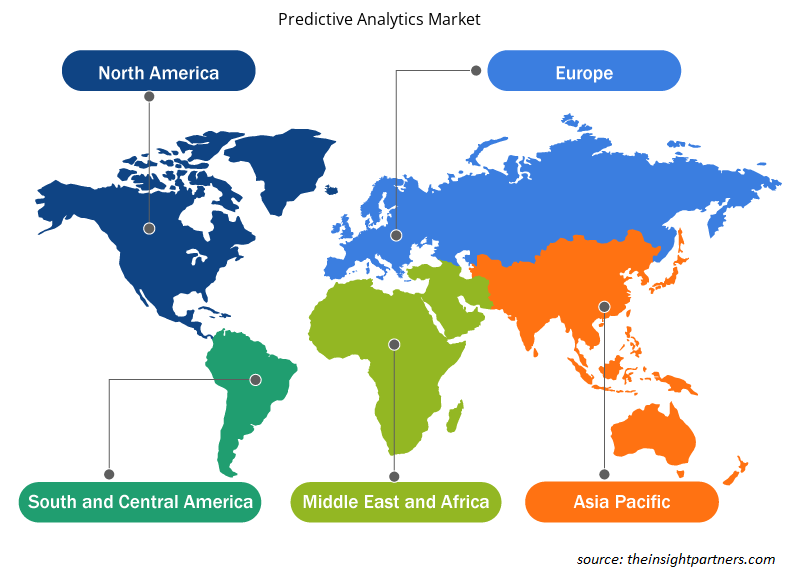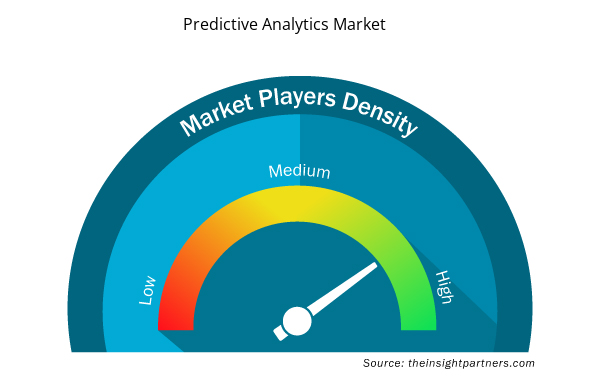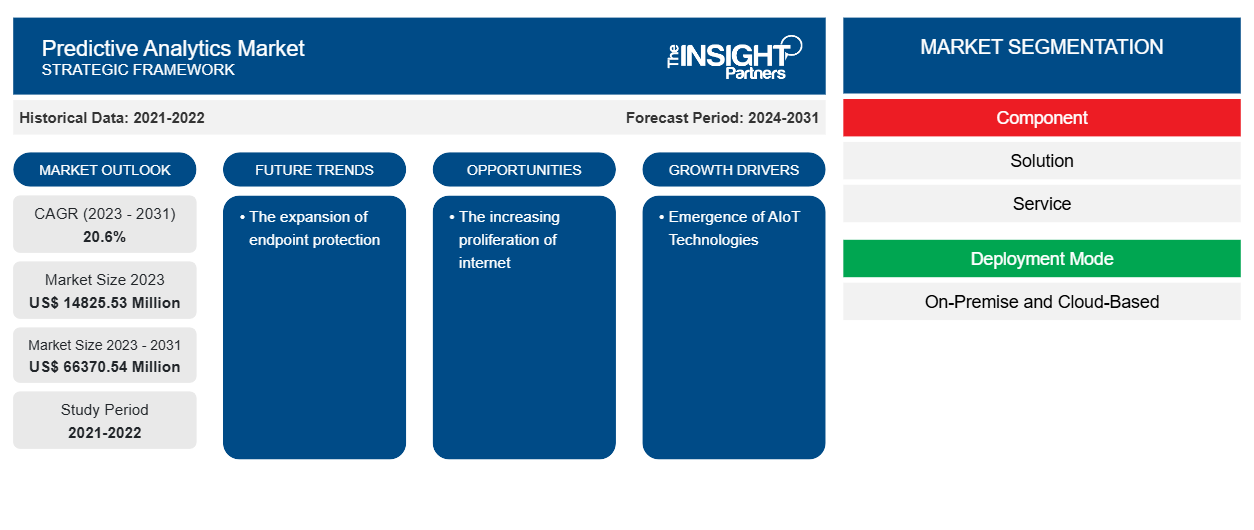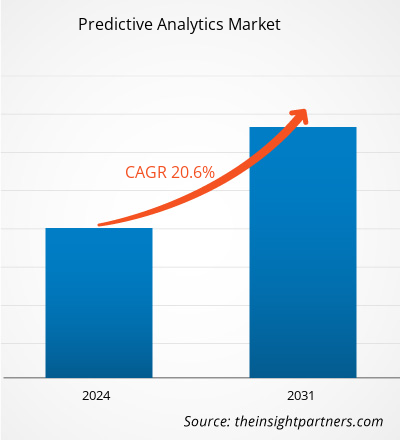من المتوقع أن يصل حجم سوق التحليلات التنبؤية إلى 66370.54 مليون دولار أمريكي بحلول عام 2031 من 14825.53 مليون دولار أمريكي في عام 2023. ومن المتوقع أن يسجل السوق معدل نمو سنوي مركب بنسبة 20.6٪ خلال الفترة 2023-2031. ومن المرجح أن يظل توسع حماية نقاط النهاية اتجاهًا رئيسيًا في السوق.
تحليلات السوق التنبؤية
مع انتشار استخدام أدوات التحليلات التنبؤية المتطورة على نطاق واسع، تستخدم الشركات الآن البيانات الضخمة للكشف بشكل استباقي عن الاحتمالات والمخاطر. أصبحت التحليلات التنبؤية الآن أكثر سهولة من أي وقت مضى بفضل التكنولوجيا الحديثة. تحتاج الشركة إلى تحديد غرض تجاري قبل أن تتمكن من استخدام التحليلات التنبؤية، سواء لتعزيز المبيعات أو تبسيط العمليات أو تعزيز رضا العملاء. بعد ذلك، باستخدام الأدوات المناسبة، قد تتمكن هذه المنظمة من إنشاء نماذج تحليلات تنبؤية وإنتاج رؤى قابلة للتنفيذ وغربلة كميات هائلة من البيانات غير المتجانسة من أجل تحقيق هذا الهدف.
نظرة عامة على سوق التحليلات التنبؤية
التحليلات التنبؤية هي مجال فرعي من التحليلات المتقدمة التي تستخدم البيانات التاريخية جنبًا إلى جنب مع النمذجة الإحصائية واستخراج البيانات والتعلم الآلي للتنبؤ بالأحداث المستقبلية. تستخدم الشركات التحليلات التنبؤية للبحث عن اتجاهات في هذه البيانات لتحديد الاحتمالات والمخاطر. غالبًا ما ترتبط التحليلات التنبؤية بعلم البيانات والبيانات الضخمة. الشركات مثقلة حاليًا بالبيانات، والتي يتم تخزينها في مستودعات بيانات مختلفة في جميع أنحاء الشركة وتتضمن ملفات السجل والصور ومقاطع الفيديو. يستخدم علماء البيانات خوارزميات التعلم الآلي والتعلم العميق لتحديد الاتجاهات في البيانات والتنبؤ بالأحداث المستقبلية من أجل استخراج رؤى قيمة. الشبكات العصبية وأشجار القرار ونماذج الانحدار اللوجستي والخطي وغيرها من التقنيات الإحصائية هي بعض من هذه. تستفيد استراتيجيات النمذجة معينة من رؤى التنبؤ الأولية للحصول على رؤى أكثر تنبؤًا.
قم بتخصيص هذا التقرير ليناسب متطلباتك
ستحصل على تخصيص لأي تقرير - مجانًا - بما في ذلك أجزاء من هذا التقرير، أو تحليل على مستوى الدولة، وحزمة بيانات Excel، بالإضافة إلى الاستفادة من العروض والخصومات الرائعة للشركات الناشئة والجامعات
- احصل على أهم اتجاهات السوق الرئيسية لهذا التقرير.ستتضمن هذه العينة المجانية تحليلاً للبيانات، بدءًا من اتجاهات السوق وحتى التقديرات والتوقعات.
محركات وفرص سوق التحليلات التنبؤية
ظهور تقنيات الذكاء الاصطناعي للأشياء (AIoT).
تتحد البنية الأساسية لإنترنت الأشياء وتقنيات الذكاء الاصطناعي لتشكيل الذكاء الاصطناعي للأشياء. يسعى الذكاء الاصطناعي إلى زيادة إدارة البيانات وتحليلها والتفاعلات بين الإنسان والآلة وكفاءة عمليات إنترنت الأشياء. يتم استخدام الذكاء الاصطناعي على نطاق واسع في التعرف على الكلام والرؤية الآلية ومعالجة اللغة الطبيعية. الذكاء الاصطناعي هو محاكاة عمليات الذكاء البشري بواسطة أجهزة الكمبيوتر، وخاصة أنظمة الكمبيوتر. إنترنت الأشياء هو نظام من أجهزة الحوسبة المترابطة والآلات الرقمية والميكانيكية أو العناصر التي قد تنقل البيانات عبر شبكة بدون واجهة من إنسان إلى إنسان أو من إنسان إلى كمبيوتر. يعد الذكاء الاصطناعي ثوريًا ومفيدًا لكلا النوعين من التكنولوجيا، حيث يعمل الذكاء الاصطناعي على تحسين عملية اتخاذ القرار ويضيف قيمة إلى إنترنت الأشياء من خلال قدرات التعلم الآلي.
الانتشار المتزايد للإنترنت
إن انتشار الإنترنت ينمو على مستوى العالم. وبالتالي، فإن التبني المتزايد لبدائل أنظمة الإضاءة ذات الأنفاق البيئية يخلق المزيد من الفرص للسوق. في بداية أبريل 2024، كان هناك 5.44 مليار مستخدم للإنترنت في جميع أنحاء العالم، أو 67.1 في المائة من إجمالي سكان العالم. يشير هذا الرقم المذهل إلى أن عدد مستخدمي الإنترنت الآن يزيد عن ضعف عدد غير المستخدمين، مما يجعل مستخدمي الإنترنت "أغلبية عظمى". كما يتزايد عدد الأشخاص الذين يستخدمون الإنترنت؛ وفقًا لأحدث الأرقام، أصبح 178 مليون شخص إضافي في جميع أنحاء العالم متصلين في العام المنتهي في أبريل 2024. وبالتالي، فإن الانتشار المتزايد للإنترنت يخلق فرصًا مختلفة لسوق التحليلات التنبؤية.
تقرير تحليلات السوق التنبؤية وتحليل التجزئة
إن القطاعات الرئيسية التي ساهمت في استنباط تحليل سوق التحليلات التنبؤية هي المكون، وطريقة النشر، وحجم المنظمة، والقطاع الرأسي.
- بناءً على المكون، ينقسم سوق التحليلات التنبؤية إلى حلول (تحليلات المخاطر، وتحليلات التسويق، وتحليلات المبيعات، وتحليلات العملاء، وغيرها) وخدمات. احتل قطاع الحلول حصة سوقية أكبر في عام 2023.
- بحسب طريقة النشر، يتم تقسيم السوق إلى محلي ومبني على السحابة. احتل قطاع السحابة حصة سوقية أكبر في عام 2023.
- بحسب حجم المنظمة، يتم تقسيم السوق إلى الشركات الصغيرة والمتوسطة (SMEs) والشركات الكبيرة.
- بحسب القطاع الصناعي، يتم تقسيم السوق إلى تكنولوجيا المعلومات والاتصالات، والخدمات المصرفية والمالية والتأمين، والطاقة والمرافق، والحكومة والدفاع، وتجارة التجزئة والتجارة الإلكترونية، والتصنيع، وغيرها.
تحليل حصة سوق التحليلات التنبؤية حسب المنطقة الجغرافية
ينقسم النطاق الجغرافي لتقرير سوق التحليلات التنبؤية بشكل أساسي إلى خمس مناطق: أمريكا الشمالية، ومنطقة آسيا والمحيط الهادئ، وأوروبا، والشرق الأوسط وأفريقيا، وأمريكا الجنوبية والوسطى.
تهيمن منطقة آسيا والمحيط الهادئ على سوق التحليلات التنبؤية. ويشهد سوق التحليلات التنبؤية في هذه المنطقة نموًا بسبب عوامل مختلفة، مثل زيادة استخدام الإنترنت والتقدم التكنولوجي. وتستثمر الشركات في المنطقة المزيد من الأموال والطاقة في تحديد حلول الإدارة الذكية المصممة خصيصًا لإدارة التهديدات الأمنية المرتبطة بنماذج العمل من المنزل. وبالتالي، من المتوقع أن تشهد سوق التحليلات التنبؤية نموًا كبيرًا في السنوات القليلة المقبلة.
رؤى إقليمية حول سوق التحليلات التنبؤية
لقد قام المحللون في Insight Partners بشرح الاتجاهات والعوامل الإقليمية المؤثرة على سوق التحليلات التنبؤية طوال فترة التنبؤ بشكل شامل. يناقش هذا القسم أيضًا قطاعات سوق التحليلات التنبؤية والجغرافيا في جميع أنحاء أمريكا الشمالية وأوروبا ومنطقة آسيا والمحيط الهادئ والشرق الأوسط وأفريقيا وأمريكا الجنوبية والوسطى.

- احصل على البيانات الإقليمية المحددة لسوق التحليلات التنبؤية
نطاق تقرير سوق التحليلات التنبؤية
| سمة التقرير | تفاصيل |
|---|---|
| حجم السوق في عام 2023 | 14825.53 مليون دولار أمريكي |
| حجم السوق بحلول عام 2031 | 66370.54 مليون دولار أمريكي |
| معدل النمو السنوي المركب العالمي (2023 - 2031) | 20.6% |
| البيانات التاريخية | 2021-2022 |
| فترة التنبؤ | 2024-2031 |
| القطاعات المغطاة | حسب المكون
|
| المناطق والدول المغطاة | أمريكا الشمالية
|
| قادة السوق وملفات تعريف الشركات الرئيسية |
|
كثافة اللاعبين في سوق التحليلات التنبؤية: فهم تأثيرها على ديناميكيات الأعمال
يشهد سوق التحليلات التنبؤية نموًا سريعًا، مدفوعًا بالطلب المتزايد من المستخدم النهائي بسبب عوامل مثل تفضيلات المستهلكين المتطورة والتقدم التكنولوجي والوعي المتزايد بفوائد المنتج. ومع ارتفاع الطلب، تعمل الشركات على توسيع عروضها والابتكار لتلبية احتياجات المستهلكين والاستفادة من الاتجاهات الناشئة، مما يؤدي إلى زيادة نمو السوق.
تشير كثافة اللاعبين في السوق إلى توزيع الشركات أو المؤسسات العاملة في سوق أو صناعة معينة. وهي تشير إلى عدد المنافسين (اللاعبين في السوق) الموجودين في مساحة سوق معينة نسبة إلى حجمها أو قيمتها السوقية الإجمالية.
الشركات الرئيسية العاملة في سوق التحليلات التنبؤية هي:
- شركة آي بي إم
- شركة مايكروسوفت
- شركة أوراكل
- ساب اس اي
- شركة جوجل المحدودة
- معهد SAS
إخلاء المسؤولية : الشركات المذكورة أعلاه ليست مرتبة بأي ترتيب معين.

- احصل على نظرة عامة على أهم اللاعبين الرئيسيين في سوق التحليلات التنبؤية
أخبار سوق التحليلات التنبؤية والتطورات الأخيرة
يتم تقييم سوق التحليلات التنبؤية من خلال جمع البيانات النوعية والكمية بعد البحث الأولي والثانوي، والذي يتضمن منشورات الشركات المهمة وبيانات الجمعيات وقواعد البيانات. فيما يلي بعض التطورات في سوق التحليلات التنبؤية:
- أعلنت شركة mPulse، الشركة الرائدة في مجال الذكاء الاصطناعي التفاعلي وحلول المشاركة الرقمية لصناعة الرعاية الصحية، عن زخم قوي في الربع الأول من عام 2024 مقارنة بالربع الأول من عام 2023 مع نمو في جميع قطاعات الأعمال. كما أعلنت الشركة عن إطلاق قدرات منتجات التحليلات التنبؤية المتكاملة والمشاركة متعددة القنوات، مما أدى إلى إنشاء فئة جديدة ضمن النظام البيئي للصحة الرقمية. (المصدر: mPulse، بيان صحفي، مايو 2024)
- أعلنت شركة AVEVA، الشركة العالمية الرائدة في مجال البرمجيات الصناعية، والتي تعمل على تعزيز الابتكار والاستدامة، عن إطلاق أحدث إصدار من برنامج AVEVA Predictive Analytics، والذي تم تصميمه خصيصًا للمراقبة التنبؤية للأصول الصناعية في قطاعات النفط والغاز والطاقة والمواد الكيميائية والتعدين والمعادن والتصنيع. يساعد البرنامج المشغلين الصناعيين على تحقيق أعلى مستويات الموثوقية والأداء الممكنة للأصول الصناعية مع تحسين الاستدامة وزيادة إنتاجية القوى العاملة. (المصدر: AVEVA، بيان صحفي، فبراير 2023)
تغطية تقرير سوق التحليلات التنبؤية والمنتجات النهائية
يوفر تقرير "حجم سوق التحليلات التنبؤية والتوقعات (2021-2031)" تحليلاً مفصلاً للسوق يغطي المجالات التالية:
- حجم سوق التحليلات التنبؤية والتوقعات على المستويات العالمية والإقليمية والوطنية لجميع قطاعات السوق الرئيسية التي يغطيها النطاق
- اتجاهات سوق التحليلات التنبؤية بالإضافة إلى ديناميكيات السوق مثل المحركات والقيود والفرص الرئيسية
- تحليل مفصل لقوى PEST/Porter الخمس وSWOT
- تحليل سوق التحليلات التنبؤية الذي يغطي اتجاهات السوق الرئيسية والإطار العالمي والإقليمي والجهات الفاعلة الرئيسية واللوائح والتطورات الأخيرة في السوق
- تحليل المشهد الصناعي والمنافسة الذي يغطي تركيز السوق، وتحليل خريطة الحرارة، واللاعبين البارزين، والتطورات الأخيرة لسوق التحليلات التنبؤية
- ملفات تعريف الشركة التفصيلية
- التحليل التاريخي (سنتان)، السنة الأساسية، التوقعات (7 سنوات) مع معدل النمو السنوي المركب
- تحليل PEST و SWOT
- حجم السوق والقيمة / الحجم - عالميًا وإقليميًا وقطريًا
- الصناعة والمنافسة
- مجموعة بيانات Excel



Report Coverage
Revenue forecast, Company Analysis, Industry landscape, Growth factors, and Trends

Segment Covered
This text is related
to segments covered.

Regional Scope
North America, Europe, Asia Pacific, Middle East & Africa, South & Central America

Country Scope
This text is related
to country scope.
الأسئلة الشائعة
The expected CAGR of the global predictive analytics market is 20.6%.
The global predictive analytics market is expected to reach US$ 66370.54 million by 2031.
The expansion of endpoint protection is anticipated to play a significant role in the global predictive analytics market in the coming years.
The key players holding majority shares in the global predictive analytics market are IBM Corporation, Microsoft Corporation, Oracle Corporation, SAP SE, Google LLC, SAS Institute Inc., Salesforce.com, inc., Amazon Web Services, Hewlett Packard Enterprise Development LP (HPE), and NTT DATA Corporation.
The increasing need for road safety and the increasing adoption of environmental tunnel system lighting alternatives are the major factors that propel the global predictive analytics market.
APAC dominates the predictive analytics market.
Trends and growth analysis reports related to Technology, Media and Telecommunications : READ MORE..
The Insight Partners performs research in 4 major stages: Data Collection & Secondary Research, Primary Research, Data Analysis and Data Triangulation & Final Review.
- Data Collection and Secondary Research:
As a market research and consulting firm operating from a decade, we have published and advised several client across the globe. First step for any study will start with an assessment of currently available data and insights from existing reports. Further, historical and current market information is collected from Investor Presentations, Annual Reports, SEC Filings, etc., and other information related to company’s performance and market positioning are gathered from Paid Databases (Factiva, Hoovers, and Reuters) and various other publications available in public domain.
Several associations trade associates, technical forums, institutes, societies and organization are accessed to gain technical as well as market related insights through their publications such as research papers, blogs and press releases related to the studies are referred to get cues about the market. Further, white papers, journals, magazines, and other news articles published in last 3 years are scrutinized and analyzed to understand the current market trends.
- Primary Research:
The primarily interview analysis comprise of data obtained from industry participants interview and answers to survey questions gathered by in-house primary team.
For primary research, interviews are conducted with industry experts/CEOs/Marketing Managers/VPs/Subject Matter Experts from both demand and supply side to get a 360-degree view of the market. The primary team conducts several interviews based on the complexity of the markets to understand the various market trends and dynamics which makes research more credible and precise.
A typical research interview fulfils the following functions:
- Provides first-hand information on the market size, market trends, growth trends, competitive landscape, and outlook
- Validates and strengthens in-house secondary research findings
- Develops the analysis team’s expertise and market understanding
Primary research involves email interactions and telephone interviews for each market, category, segment, and sub-segment across geographies. The participants who typically take part in such a process include, but are not limited to:
- Industry participants: VPs, business development managers, market intelligence managers and national sales managers
- Outside experts: Valuation experts, research analysts and key opinion leaders specializing in the electronics and semiconductor industry.
Below is the breakup of our primary respondents by company, designation, and region:

Once we receive the confirmation from primary research sources or primary respondents, we finalize the base year market estimation and forecast the data as per the macroeconomic and microeconomic factors assessed during data collection.
- Data Analysis:
Once data is validated through both secondary as well as primary respondents, we finalize the market estimations by hypothesis formulation and factor analysis at regional and country level.
- Macro-Economic Factor Analysis:
We analyse macroeconomic indicators such the gross domestic product (GDP), increase in the demand for goods and services across industries, technological advancement, regional economic growth, governmental policies, the influence of COVID-19, PEST analysis, and other aspects. This analysis aids in setting benchmarks for various nations/regions and approximating market splits. Additionally, the general trend of the aforementioned components aid in determining the market's development possibilities.
- Country Level Data:
Various factors that are especially aligned to the country are taken into account to determine the market size for a certain area and country, including the presence of vendors, such as headquarters and offices, the country's GDP, demand patterns, and industry growth. To comprehend the market dynamics for the nation, a number of growth variables, inhibitors, application areas, and current market trends are researched. The aforementioned elements aid in determining the country's overall market's growth potential.
- Company Profile:
The “Table of Contents” is formulated by listing and analyzing more than 25 - 30 companies operating in the market ecosystem across geographies. However, we profile only 10 companies as a standard practice in our syndicate reports. These 10 companies comprise leading, emerging, and regional players. Nonetheless, our analysis is not restricted to the 10 listed companies, we also analyze other companies present in the market to develop a holistic view and understand the prevailing trends. The “Company Profiles” section in the report covers key facts, business description, products & services, financial information, SWOT analysis, and key developments. The financial information presented is extracted from the annual reports and official documents of the publicly listed companies. Upon collecting the information for the sections of respective companies, we verify them via various primary sources and then compile the data in respective company profiles. The company level information helps us in deriving the base number as well as in forecasting the market size.
- Developing Base Number:
Aggregation of sales statistics (2020-2022) and macro-economic factor, and other secondary and primary research insights are utilized to arrive at base number and related market shares for 2022. The data gaps are identified in this step and relevant market data is analyzed, collected from paid primary interviews or databases. On finalizing the base year market size, forecasts are developed on the basis of macro-economic, industry and market growth factors and company level analysis.
- Data Triangulation and Final Review:
The market findings and base year market size calculations are validated from supply as well as demand side. Demand side validations are based on macro-economic factor analysis and benchmarks for respective regions and countries. In case of supply side validations, revenues of major companies are estimated (in case not available) based on industry benchmark, approximate number of employees, product portfolio, and primary interviews revenues are gathered. Further revenue from target product/service segment is assessed to avoid overshooting of market statistics. In case of heavy deviations between supply and demand side values, all thes steps are repeated to achieve synchronization.
We follow an iterative model, wherein we share our research findings with Subject Matter Experts (SME’s) and Key Opinion Leaders (KOLs) until consensus view of the market is not formulated – this model negates any drastic deviation in the opinions of experts. Only validated and universally acceptable research findings are quoted in our reports.
We have important check points that we use to validate our research findings – which we call – data triangulation, where we validate the information, we generate from secondary sources with primary interviews and then we re-validate with our internal data bases and Subject matter experts. This comprehensive model enables us to deliver high quality, reliable data in shortest possible time.


 احصل على عينة مجانية لهذا التقرير
احصل على عينة مجانية لهذا التقرير